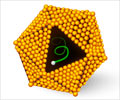Contrary to current beliefs, sugar intake is not directly connected to nonalcoholic fatty liver disease contends a new study that attributes high-calorie diets for progression of this serious disease.

"Based on the results of our study, recommending a low-fructose or low-glycemic diet to prevent nonalcoholic fatty liver disease is unjustified," said Professor Ian A. Macdonald, study author and faculty of medicine and health sciences, University of Nottingham, UK. "The best advice to give a patient is to maintain a healthy lifestyle with diet and exercise. Our study serves as a warning that even short changes in lifestyle can have profound impacts on your liver."
During the period of increased calorie intake, all study participants experienced significant increases in body weight, waist circumference and total body fat, as expected. Interestingly, satiety was unaltered in spite of weight gain during the high-calorie diet; this reinforces the notion of "hidden calories" in drinks since participants consumed a portion of their calories in liquid form.
Fructose is a simple sugar commonly found in fruits and vegetables. Glucose, also known as grape or blood sugar, is present in all major carbohydrates, such as starch and table sugar.
Nonalcoholic fatty liver disease, the most prevalent liver problem in the U.S. and most Western countries, is the buildup of extra fat in liver cells that is not caused by alcohol. For more on how a low-calorie diet is the best prescription for this form of liver disease, read the article http://www.gastro.org/journals-publications/aga-perspectives/octobernovember-2013/nafld-treatment-is-there-more-to-talk-about-other-than-diet-and-exercise, from the October/November issue of AGA Perspectives, the AGA Institute's most prominent non-scientific publication.
Advertisement















